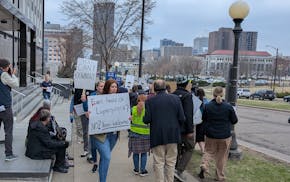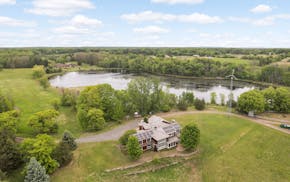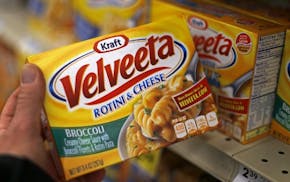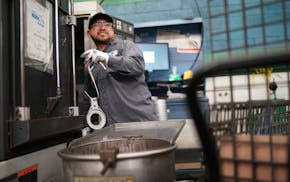When he closed his eyes for the last time before surgery, Kevin Manion knew he might not wake up with a new heart beating in his chest.
After suffering four heart attacks, the 57-year-old Chanhassen man was hoping that a heart donated by someone taken off life support hours earlier could successfully replace his own heavily damaged heart.
The new heart would be transported inside a special machine that pumps it full of oxygenated blood and keeps it beating. But heart-transplant recipients are routinely warned that the procedure can be called off at the last minute if there's a problem with the donated organ.
Hours after going under sedation Jan. 30, Manion woke up in the intensive care unit (ICU) at Abbott Northwestern Hospital in south Minneapolis with a freshly closed chest incision and a breathing tube down his throat. He noticed one of his surgeons, Dr. Benjamin Sun, seemed happy.
"I asked him if we did the whole operation," Manion recalled. "And he said, 'Yep, we did the whole thing.' "
Hearts aren't normally transplanted after the donor's heart stops beating. But Manion is among a small but growing number of people to receive a heart donated after circulatory death, or DCD.
About 120 other people in the United States have received DCD heart transplants as part of a clinical trial using a system called the TransMedics OCS Heart, often referred to as a "Heart in a Box." It's a table-sized, battery-powered medical device that acts as a life-support system and mobile lab for the heart.
Manion was the second patient in Minnesota to receive a DCD heart as part of a trial involving the Minneapolis Heart Institute Foundation. TransMedics executives hope it will lead to nationwide approval for DCD heart transplants with the device sometime early next year, eventually reducing wait times for patients on heart-transplant lists.
A second trial site in Minneapolis is coming online through the University of Minnesota Medical School.
Unusual in several ways
Using a heart that had been stopped before procurement wasn't the only unusual aspect of Manion's procedure.
Another was that the surgical team — including Sun and fellow Minneapolis Heart Institute surgeons Dr. Karol Mudy and Dr. Bassam "Sammy" Shukrallah — used the TransMedics device to scrutinize and medically manage the heart for hours after it was procured from the donor.
"The machine will oxygenate the blood, put blood into the coronaries, and then the heart wakes up," said Sun, surgical director of heart failure at the Minneapolis Heart Institute. "We pace it, and then we use medications. And we're running a mini ICU on this heart now."
Procuring a heart from a donor after they've been disconnected from life support is only possible with the TransMedics device, because it allows doctors to assess whether the organ's death rendered it unsuitable for transplant.
"Essentially, the heart is incurring an insult for the patient to pass. It has to completely stop," Shukrallah said. "When it completely stops, and we reanimate it. … We want to make sure that that insult did not damage it."
By agreeing to accept a heart that was restarted inside a machine about 30 minutes after it stopped beating, Manion joined a much shorter waiting list of advanced heart-failure patients seeking transplants.
There were 3,521 people, including 120 Minnesotans, on the regular heart-transplant waiting list as of last week. More than 70% of the Minnesotans had been on the list for more than a year, according to the federal Organ Procurement and Transplantation Network.
Manion got the call from Minneapolis Heart Institute's Erin Hannibal less than a week after consenting to get a DCD heart.
"Erin, one of the transplant coordinators, says, 'We've located a heart for you. Are you ready?' I just said, 'Yeah. Let's do it,' " Manion said. "It seemed to happen fast, and it did happen fast. [But] it was a lot longer in the making."
Transplant history
The first human-to-human heart transplant in an adult took place in Cape Town, South Africa, in December 1967. The first in the U.S. came a month later at Stanford Hospital in California. Both patients died within a month.
Both lead surgeons — Dr. Christiaan Barnard in Cape Town and Dr. Norman Shumway in Stanford — had trained in the University of Minnesota's pioneering surgery program in the decade before the transplants.
In those days, all heart transplants were essentially DCD transplants, but the procedure was much different from today.
"In the '60s and '70s they would bring the donor to the recipient's hospital," said Mudy, principal investigator for the Minneapolis Heart Institute Foundation DCD study site. "They would withdraw [life] support, the heart would die, and they would take it out and transplant it."
Dr. Tamer Khayal, chief commercial officer at Massachusetts-based TransMedics, said "suboptimal" results from those early procedures led to surgeons only procuring hearts from patients who were brain dead but on life support.
Clinical data suggest the OSC Heart allows DCD heart transplants to be done safely and reliably. In fact, the machine more than doubles the time the heart can be outside the body, and it creates a trail of data in the process.
Minnesota's first DCD heart donor with the new technology was 19-year-old Wyatt Bothun, a registered organ donor who died unexpectedly in a Minneapolis hospital last September.
Bothun, who graduated from Burnsville High School in 2019, was an avid urban cave explorer who dabbled in writing music, enjoyed sports, held the Burnsville High record for the bench press and dreamed of becoming a welder.
Bothun donated his heart, kidneys, liver and pancreas. While the other organs can be donated after the heart stops beating, the heart requires special equipment for a donation after circulatory death.
"I know he would just be really happy and proud that he got to be the hero in so many stories," said his grandmother, Jan Sautter of Savage.
Physicians at the Minneapolis Heart Institute Foundation said the pool of potential DCD heart donors includes patients with no chance of meaningful recovery after neurological traumas, such as injury caused by a car crash. TransMedics' Khayal said catastrophic stroke patients who have no chance of meaningful recovery may also be a source of DCD hearts.
LifeSource, the regional organ procurement organization in Minneapolis that matches potential donors with recipients, estimates DCD hearts could increase the total supply by 20% if the TransMedics device is approved by the FDA. LifeSource recovered 60 hearts in 2019.
Will they last?
Yet it is unknown how durable DCD hearts will be in the long run.
Researchers in Australia transplanted 23 DCD hearts through 2018 and found overall survival and organ-rejection episodes comparable to traditional outcomes, with 4% mortality after four years. Researchers at Royal Papworth Hospital in the United Kingdom transplanted 79 DCD hearts and found the one-year survival rate was 91%, compared to 89% in a cohort of traditional patients.
Manion, meanwhile, is focused on rebuilding his strength and stamina so he can walk his two border collie mixes again. He recently started back with walks and has been tracking his distance with a new FitBit.
"The longest I've gone so far is 2.84 kilometers," or 1.8 miles, he said. "I feel like, for just a week, that's pretty decent."
Joe Carlson • 612-673-4779

Minnesota Department of Health rescinds health worker layoffs

Eco-friendly house on 30 acres near Marine on St. Croix listed at $1.6M

DOGE cuts federal money for upgrades at Velveeta plant in New Ulm

